ENTOMOLOGY EXAM 4- FINAL
1/175
There's no tags or description
Looks like no tags are added yet.
Name | Mastery | Learn | Test | Matching | Spaced |
|---|
No study sessions yet.
176 Terms
social in the context of social insects means what
cooperative behavior
2 types of social insects
subsocial
eusocial
subsocial insect
less teamwork and sharing of reproductive roles
eusocial insect
diversion of reproductive labor, some breed and some don’t
example of eusocial insects
termites, bees, wasps
orders: blattodea & hymenoptera
families: termitidae, apidae, vespidae, ichneumonidae
3 requirements for eusociality
division of labor with a caste system (reproductive being the highest caste)
cooperation- helping another reproduce
overlap of genetics
what are the main eusocial insects?
ants
order hymenoptera
family formicidae
T/F- All termite socieities are eusocial
T
T/F all termite males and females are equally present
T
T/F- nymphal stages are active helpers in termite societies
T
what is the sociability of many bees?
subsocial, but most are solitary
example of eusocial hymenoptera
some bees
all ants
some wasps
T/F - all ant species are eusocial
T
How many ant queens per colony in most species?
1
T/F- most queen ants are intiially winged, shed after mating
T
All ant workers are what gender?
female
monomorphic workers mean
one type
leafcutter ant societies nest most commonly where?
in the ground
Leaf cutter ants cultivate what on cuttings?
fungus on cuttings in underground chambers They feed on fungus fruiting bodies and have enormous nests
carpenter ant socieities nest where?
in plants
domatia
plants grow spaces for nests; ants provide protection
weaver ants do what with leaves?
pull leaves together with silk but only larvae can produce silk
where do army ants nest?
temporary shelters, they are nomades
supercolonies-
have multiple queens
/////////////////LECTURE 2 BELOW//////////////
///////LECTURE 2 BELOW//////////
T/F- honey bee workers are monomorphic
T
T/F- honey bee workers live 4-6 weeks in summer, fall individual will overwinter
T
T/F - honey bee workers have a stinger that can only be used once
T
honey bee workers
hive bees- young workers
older bees- forage for food
honey bee is a genus of how many species?
6 or 7
what bee was domesticed and has become essential to modern agriculture?
western honey bee
honey comb
chambers made out of wax from abdominal glands
purpose is to develop larvae and hold nectar and pollen
honey bee males
short lived
also called “drones”
only role to mate with virgin queens
how do honeybees communicate?
waggle dance
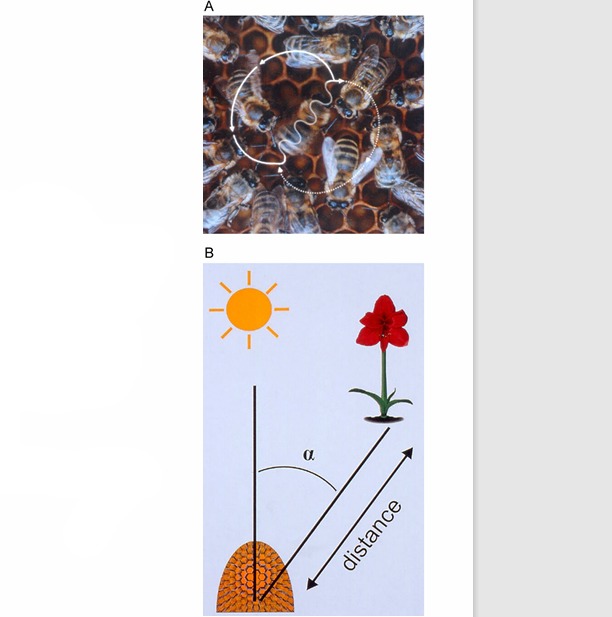
waggle dance
done by honey bees
figure 8
length of straight portion= distance from source is in terms of energy expended
angle of the straight portion w/ respect to gravity = direction
head up = toward sun
head down = opposite sun
how is a honey bee queen determined
by additional feeding during development
royal jelly
increased sugar concentration,
gland products,
and royalactin (signal protein)
/////////////LECTURE 3 BELOW////////////
//////////LECTURE 3 BELOW///////////
mites attach what of the honey bee?
trachael system, very prevelant in the abdomen
CCD
colony collapse disorder is when disappearing worker caste, they just leave and dont come back
“killer bees” afracanized honey bees
hybrid between european honey bees and african honey bee
the killer bee aricanized honey bee is more agrassive than what?
the european honey bee
what are possible caused of CCD?
pathogens
managements
environmental
////////////HYMENOPTERA BELOW//////////////
////////////HYMENOPTERA BELOW//////////////
benefits of hymenoptera
pollination
pest control
soil development/ aeration
Hamuli
hooks on hind wings, attatch forewing
mouthparts of hymenoptera are what
chewing and sucking
hymenoptera has what kind of waist
wasp waist
hymenoptera femals have what ploidy?
femdiploid (2n)- arise from fertilized eggs
hymenoptera males have what ploidy?
haploid (1n)- arise from unfertilized eggs
the ploidy of hymenoptera is enabled by what?
spermatheca
broad waist hymenoptera suborder?
symphyta
narrow waist hymenoptera suborder?
apocrita
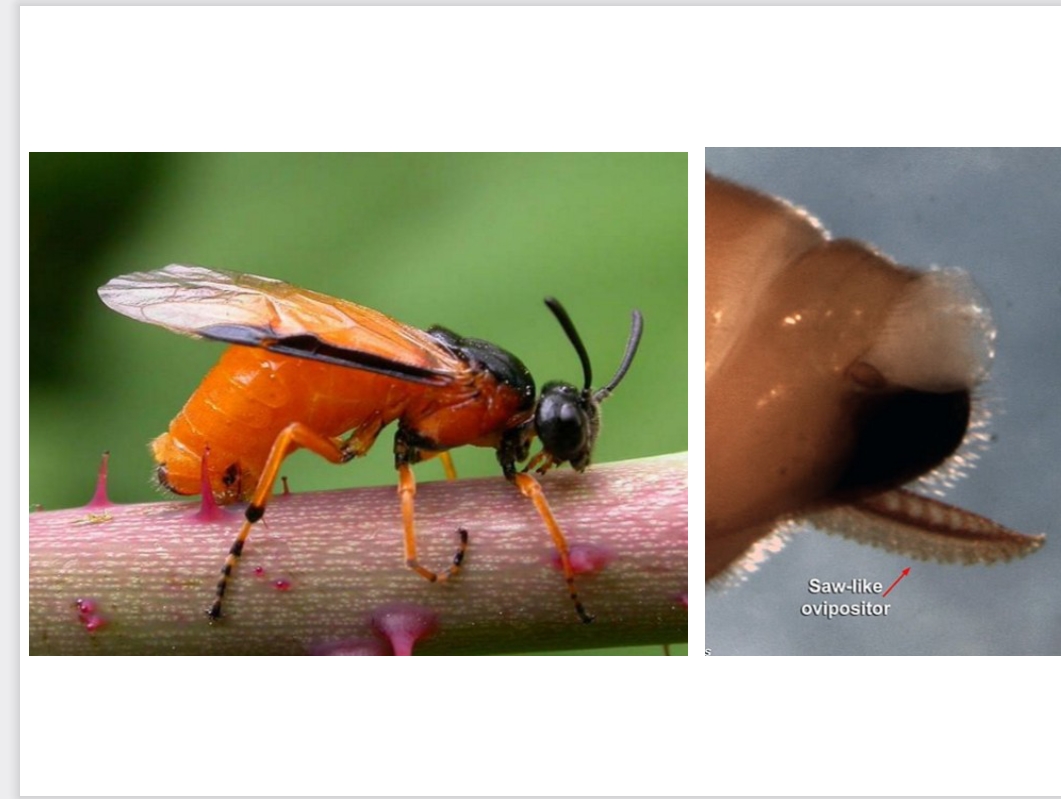
what suborder is this?
saw like ovipositor that saws out wood than lays egg
symphyta
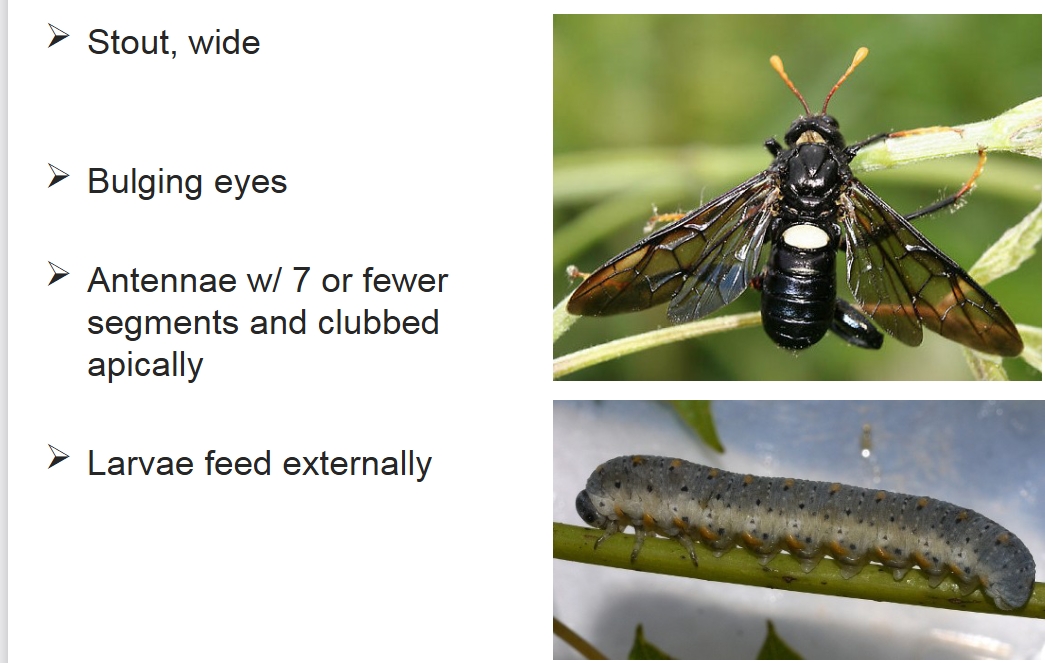
what family is this?
cimbicidae - cimbicid sawflies
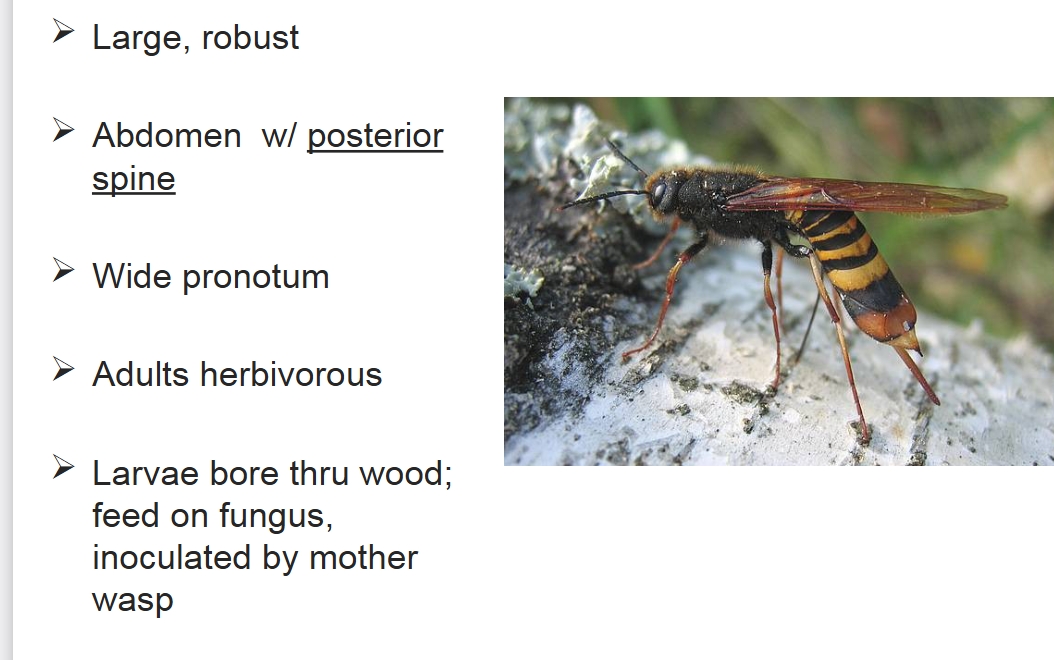
what family is this?
siricidae - horntails/ siricid wood wasp
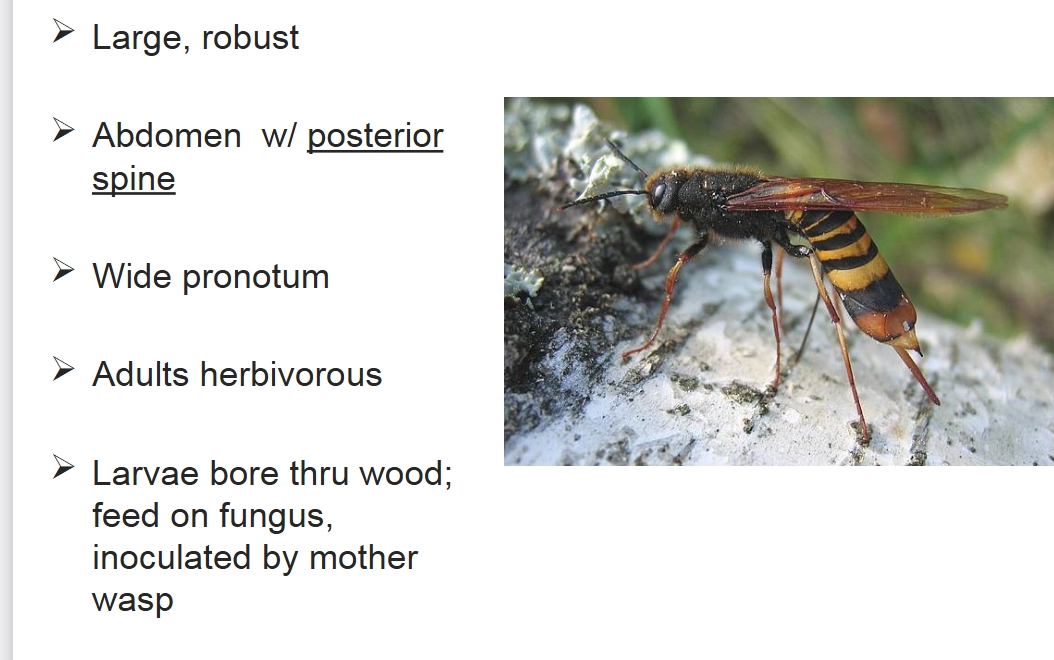
what family has a horntail as a diagnostic feature?
siricidae
mesosoma
thorax + segment 1 of the abdomen
metasoma
abdominal segments 2+
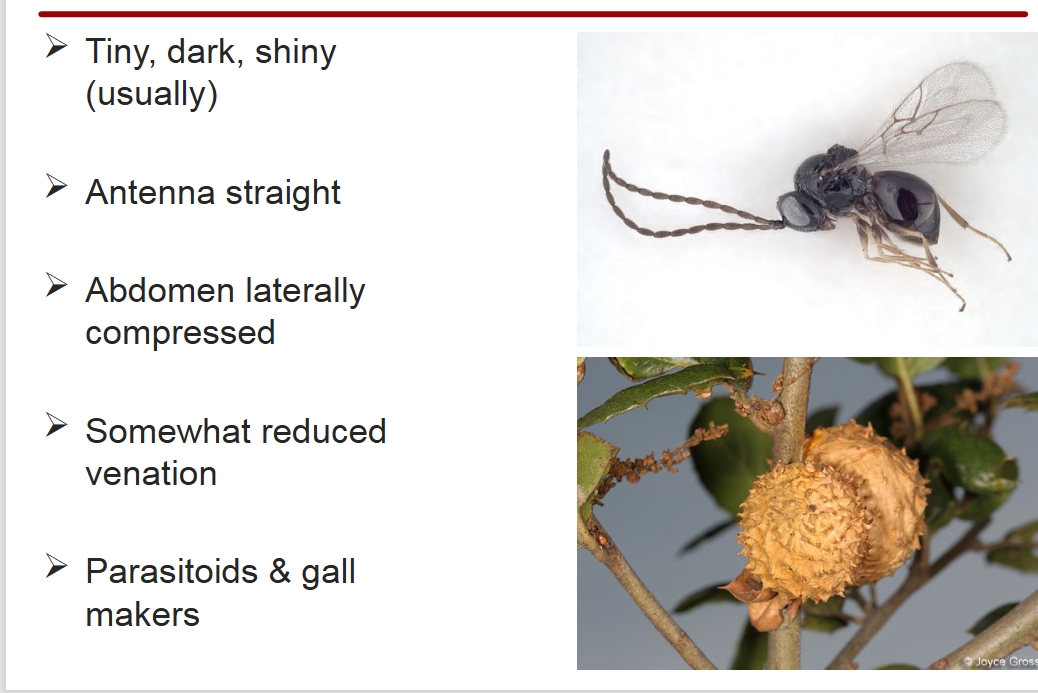
what superfamily is this?
Cynipoidea- gall Wasps
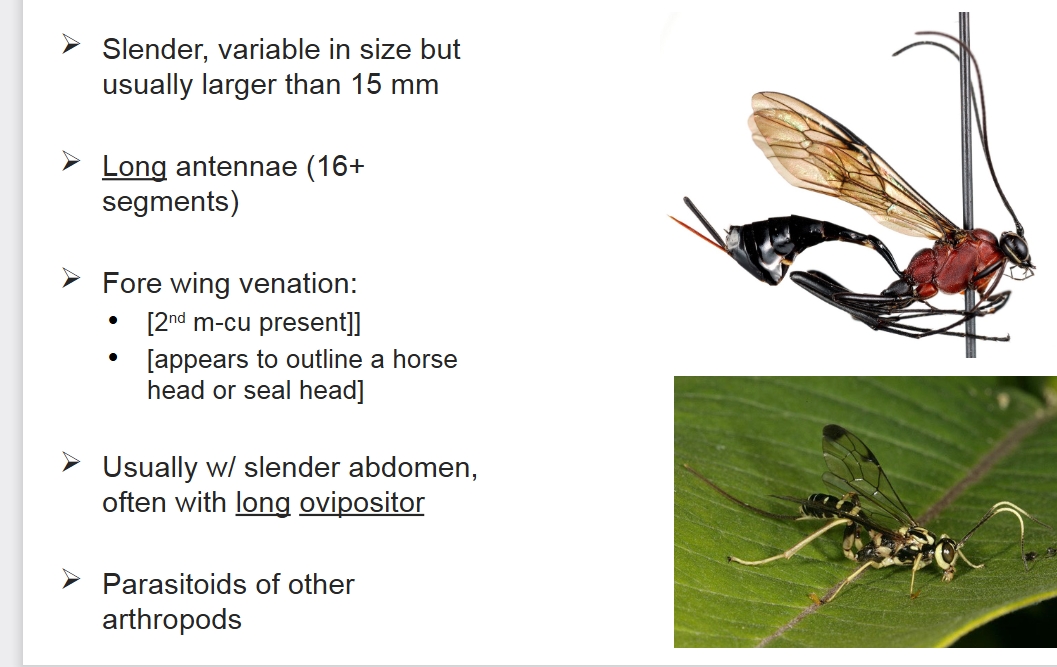
what superfamily is this?
Ichneumonidae – Ichneumon Wasps
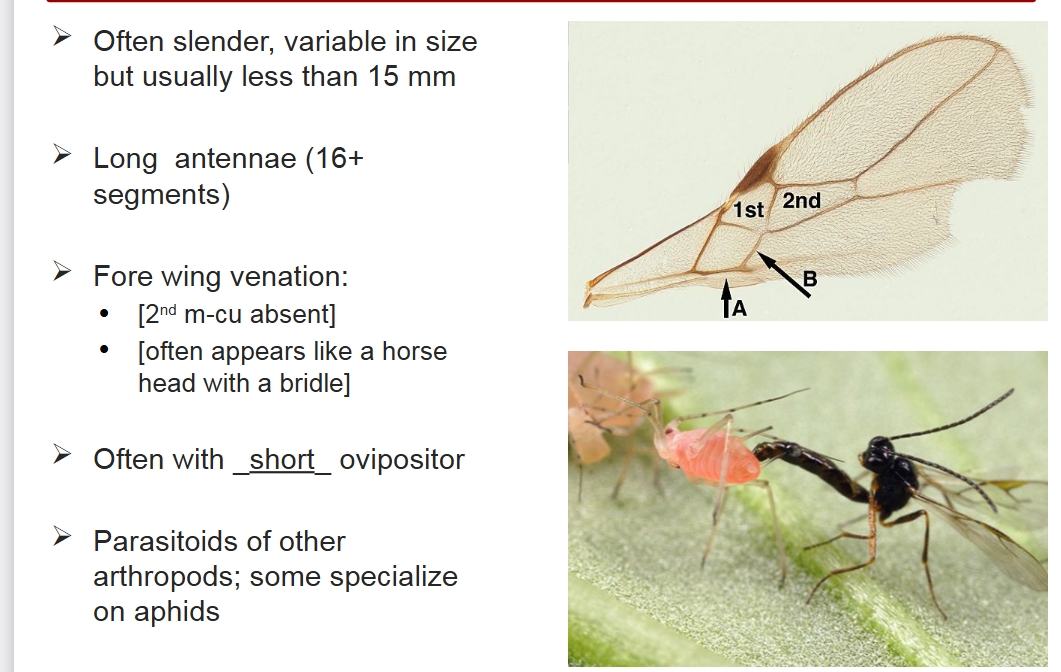
what family is this?
Braconidae – Braconid Wasps
stinging hymenoptera
Ovipositor converted into a
true sting –
• Offensive & defensive
function
• Associated venom glands
Egg laid at base of ovipositor
rather than the tip as in other
hymenopterans
Males have no ovipositor,
males don’t sting
Suborder Symphyta
- Cimbicidae
- Siricidae
Suborder Apocrita
- Cynipoidea
- Chalcidoidea
- [Ichneumonoidea]
- Ichneumonidae
- Braconidae
-[Aculeata]
-[Chyridoidea]
- Chrysididae
-[Vespoidea]
- Vespidae
- Formicidae
- Pompilidae
- Mutillidae
[Apoidea]
- Sphecidae
- Apidae
- Megachilidae

Name the suborder and family, and diagnostic features for each.
Suborder Symphyta (broad waist);
family Siricidae,
horntail (spine at tip of abdomen) but
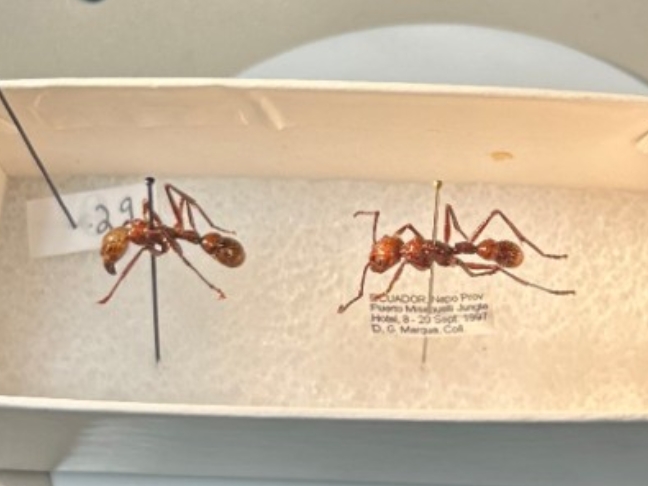
29
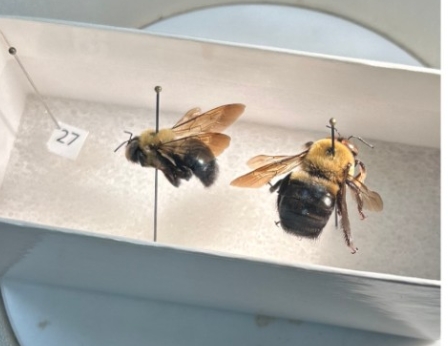
27
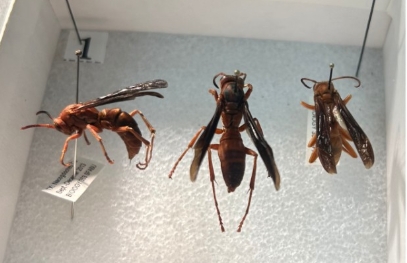
Name the order, suborder, and family and a diagnostic feature for each.
Hymenoptera (hamuli),
Apocrita (wasp waist),
Vespidae, paper wasp;
fore wings longitudinally folded
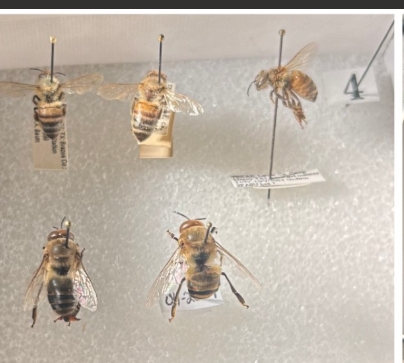
Name the family and common name for the genus, and a diagnostic feature for each.
Apidae (3 submarginal cells), honey bee (medium size, orange & black coloration)
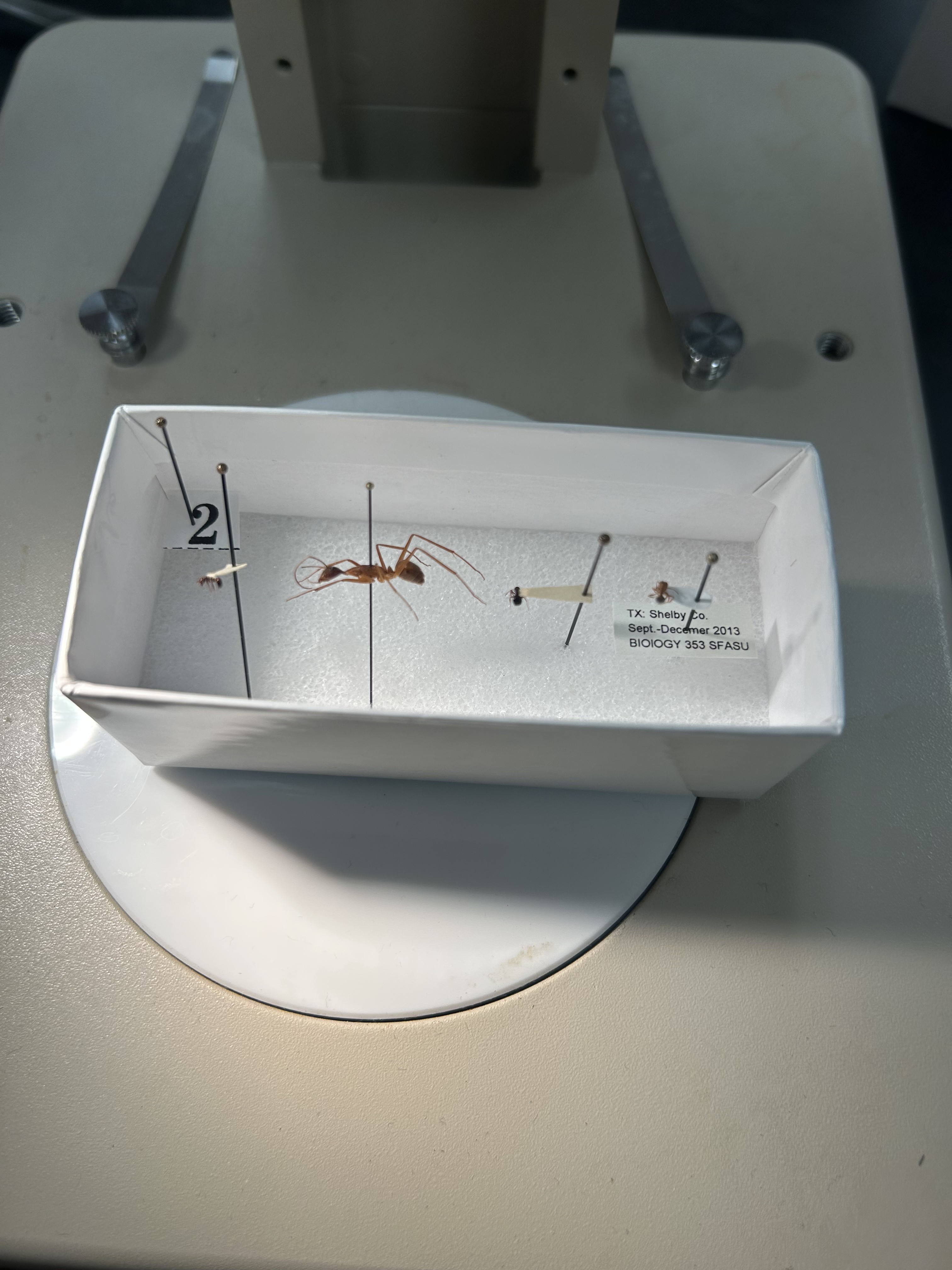
2. Name the family and a diagnostic feature.
Formicidae- army ant
abdomen with nodose/humped petiole
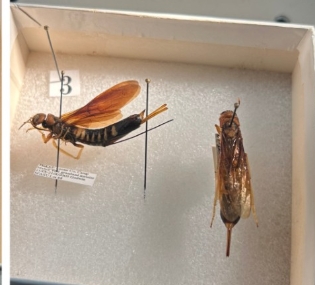
Name the suborder and family, and diagnostic features for each.
Suborder Symphyta (broad waist);
family Siricidae,
horntail (spine at tip of abdomen)
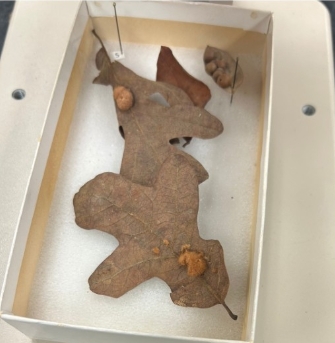
Name the superfamily that made this.
Cynipoidea (gall wasp galls)
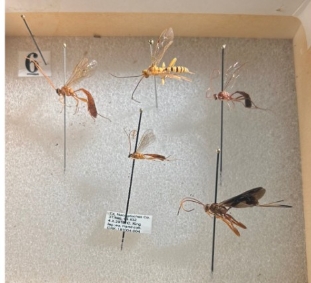
Name the family and a diagnostic feature.
Ichneumonidae, ichneumon wasp (forewing 2nd m-cu present, "horse/seal head" pattern in fore wing
more curved antennae
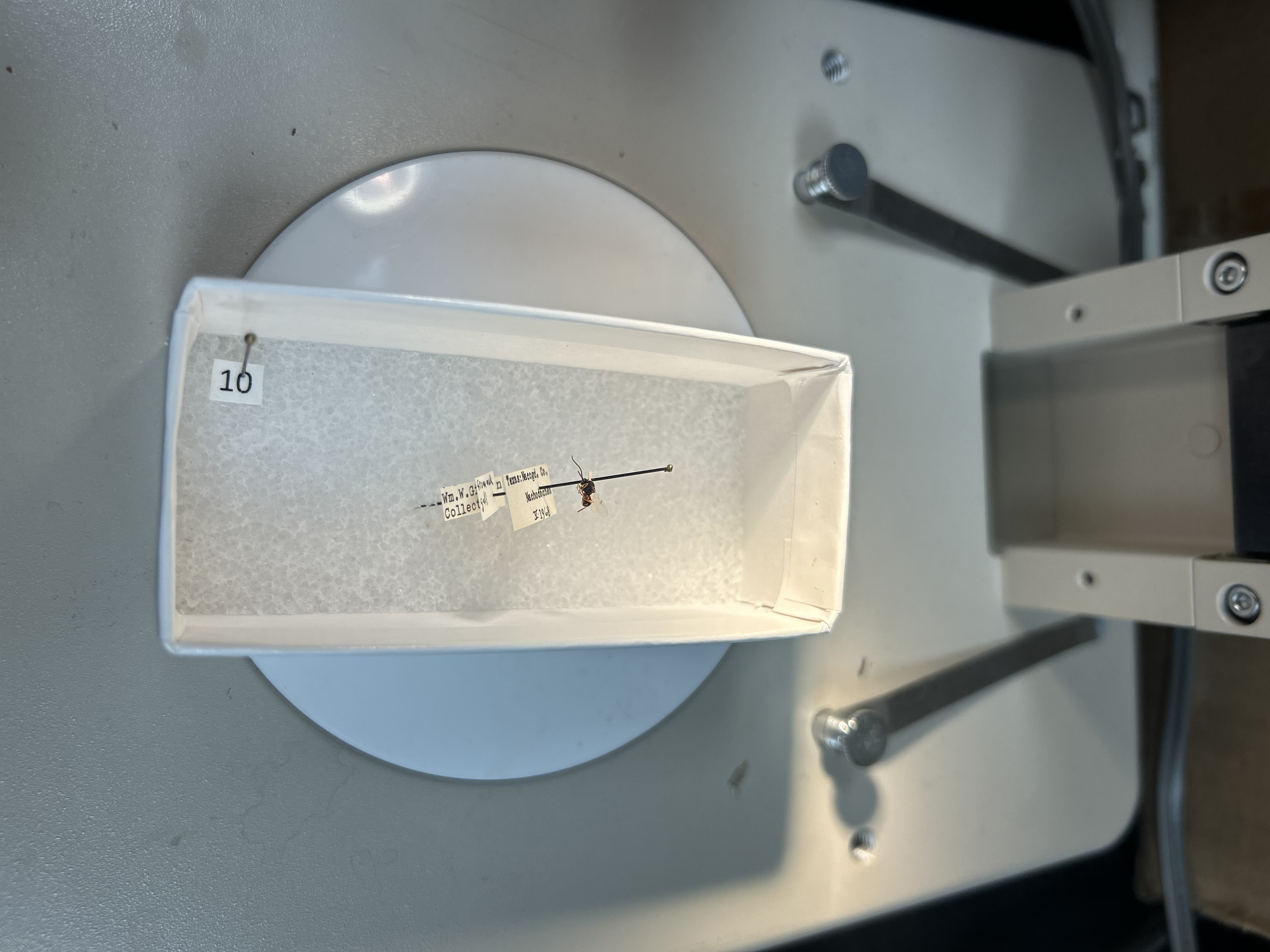
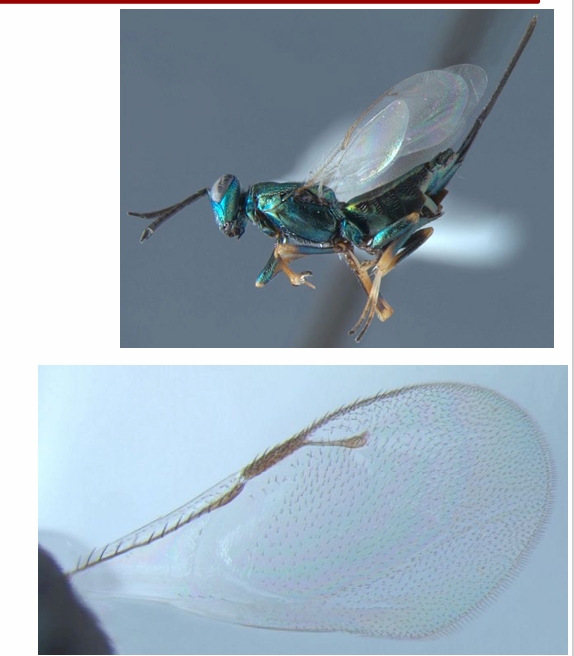
Name the superfamily and a dognostic feature
)
Chalcidoidea, fairy watp (metallic euleration, radoond forewing venation offen with a characteristic vein sub

name the family and a diagnostic feature
Braconidae- braconid wasps
appearance if horse head with a bridle in wing
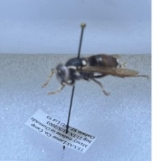
Name the family.
Vespidae, hormet, (fore wings fongitudinally folded)
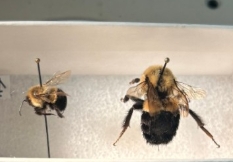
Name the family, common name for the genus, and a diagnostic feature for this genus
Apidae, bumble bee (large, "hairy" including the top of the abdomen)
![<p>. Name two farsilies that have at least some members that use mul to build netsts. (n.1. 3 if you include organ pipe mud daubers]</p><p></p><p></p>](https://knowt-user-attachments.s3.amazonaws.com/2b127ed6-4aad-4836-b47b-2b6b29cc7d29.jpg)
. Name two farsilies that have at least some members that use mul to build netsts. (n.1. 3 if you include organ pipe mud daubers]
Sphecidae, Vespidae
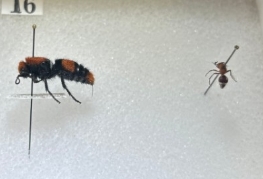
Name the family and a diagnostic feature.
)
Mutillidae, (velvet ant, bright colors, loss of wings in female
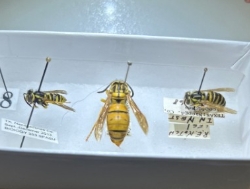
. Name the family.
Vespidae, hornet, fore wings longitudinally folded
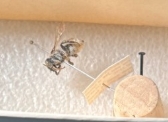
Name the family and a diagnostic feature
Megachilidae, leaf cutter bee, (poilen stored on abdominal scopa/tong hairs)
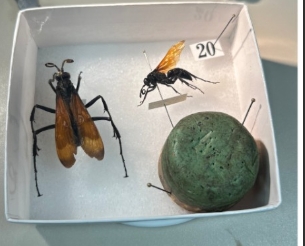
Name the family and a diagnostic feature. What does it feed on as a larva?
pompilidae- spider wasps
larvae are parasitoids of spiders. 1 spider per larvae
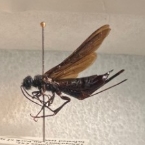
Name the funily
Siricidae – Horntails/Siricid Wood Wasp
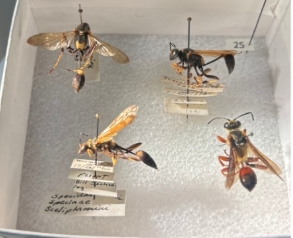
Name the family.
Sphecidae – sphecids, mud daubers, etc
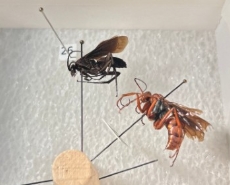
Name the family.
Pompilidae- spider wasp
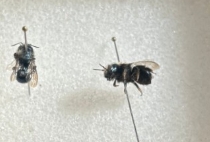
Naine the family and a diagnostic character.
Megachilidae – Megachilid Bees
pollon collecting hairs on abdomen

Name the family and a common name for the genus.
Apidae, Carpenter bee

?
Braconidae ?
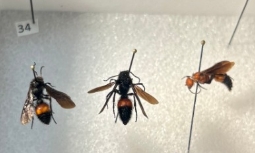
Name the family
Mutillidae – Velvet Ants
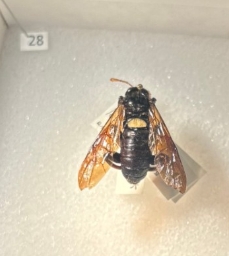
Name the suborder, family and diagnostic features
)
suborder symphyta
Cimbicidae, cimbicid wasp (large, stout, clubbed antennas
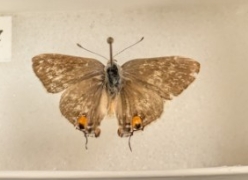
name the family and a diagnostic feature
pompilidae- swallowtail
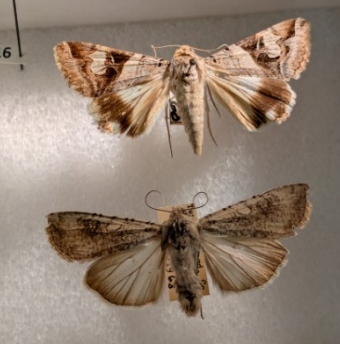
name the family
Noctuidae
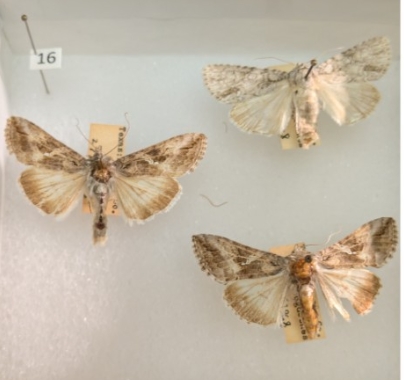
name the family
Nocturnidae
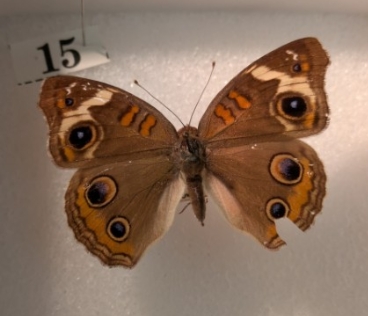
name the family-15
Nymphalidae: Brush-Footed Butterflie
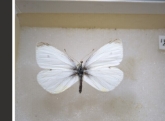
name the family
pieridae
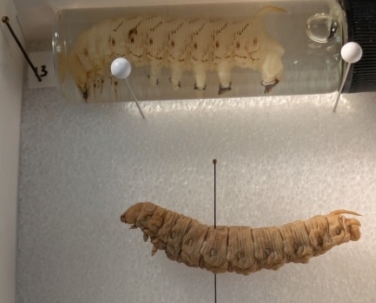
name the roder and a 2 diagnostic features of the larval stage (can you see the crochets?)
lepidoptera
disperse stemmata
5 pairs or prolegs or fewer
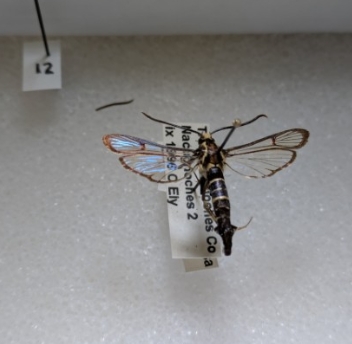
name the family and a diagnostic feature-12
sessiidae: clearwing moths

name the family and a diagnostic feature-11
Hesperiidae: skippers
antenna tip often curved

name the family and a diagnostic feature-10
nymphalidae:- brush footed butterflies
-reduced front legs
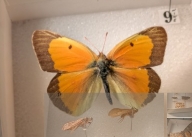
name the family and a diagnostic feature
pieridae